| Jupiter, 2004 |
| HOME Best Lunar Planets Deepsky Misc Equipment Techniques Links |
| Venus Mars Jupiter Saturn |
| 2004 2005 |
| This page shows my various attempts at capturing Jupiter and its satellites during the 2004 apparition. All these images were captured using the 114mm f/8 newtonian telescope. Click the images to see full-sized ones. |
2 May 2004
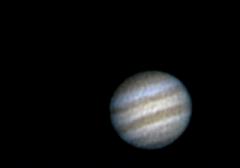
|
Seeing was not very good for this image, which was composed of the best 70% of 445 frames captured at 10 fps. Camera settings were: gain mid, brightness mid, gamma 0%, saturation max. Alignment and stacking of the images was done in K3CCDTools 2, then wavelet processing applied in Registax 2, where the central wavelet filter value was increased from 50 to 100. Layer 1 was turned off to remove some of the noise present in this image. The RGB components were composed in The Gimp, where unsharp mask and colour curve adjustment were applied. AstroAlign was used to align the RGB channels | ||
| to top | home | ||
25 April 2004
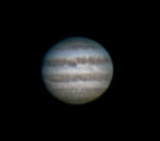
|
After a break of over a month, I returned to Jupiter to capture this image, which turned out to be one of the very best. Camera settings were: gain mid, brightness mid, gamma 0%, saturation max, 10 fps. In contrast to the image showing Ganymede from the same night, this image was aligned and stacked in Registax 2, wavelet sharpening was applied then unsharp mask and colour curve adjustment in The Gimp as usual. | ||
| to top | home | ||
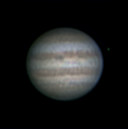
|
This image shows Ganymede after transiting the planetary disk. The Great Red Spot is just rising on the left of the picture but is only just visible. Camera settings were: gain 70%, brightness mid, gamma mid, saturation max, 10 fps. Aligned and stacked in K3CCDTools 2 planetary wizard full auto mode, then Registax 2, wavelet sharpening was applied then unsharp mask and colour curve adjustment in The Gimp. | ||
| to top | home | ||
22 March 2004: Jupiter with Io, Europa, and their shadows
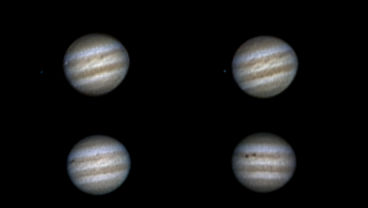
|
A montage of Europa and Io transiting Jupiter showing a nice double shadow. Conditions were very variable, and I chose the best from a number of captures. Camera settings used: 1: Shutter 1/50s, gain mid, brightness 40%, gamma 80%; 2 & 3: Shutter 1/100s, gain 70%, brightness 50%, gamma 0; 4: Shutter 1/100s, gain 70%, brightness 50%, gamma 25%; All were shot at 10fps with maximum saturation. The AVIs were aligned and stacked in K3CCDTools and Registax 2, wavelet sharpening was applied then unsharp mask and colour curve adjustment in The Gimp. | ||
| to top | home | ||
19 March 2004: Jupiter with Europa and Io
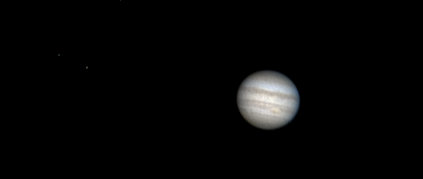
|
Finally I managed to get Jupiter and its satellites in the same picture. To do so I the cameras settings were chosen carefully: Brightness was mid, saturation max, gamma was 0, gain 50%, and shutter speed was 1/50s. Then the AVI was aligned and stacked (220 frames) in Registax 2, applied wavelets, unsharp mask and colour curve adjustment in The Gimp. | ||
| to top | home | ||
18 March 2004: Jupiter with GRS
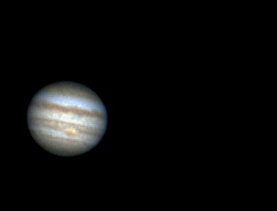
|
This shows the great red spot nicely, and some nice detail. I stacked 400 frames in K3CCDTools, applied wavelets in Registax 2, then colour adjust and unsharp mask in The Gimp, as always. Brightness was mid, saturation max, gamma was 0, gain 50%, and shutter speed was 1/50s. | ||
| to top | home | ||
2 March 2004: Jupiter after GRS passed central meridian

|
Best 939 of 1175 frames aligned and stacked in K3CCDTools, wavelets and colour tweaks in Registax 2 then unsharp mask using The Gimp. | ||
| to top | home | ||
2 March 2004: Jupiter with Great Red Spot
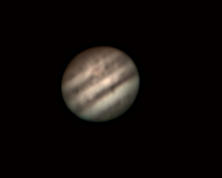 |
Aligned, stacked and enhanced with wavelets and colour tweaks in Registax 2 then resized and unsharp mask applied using The Gimp. | ||
| to top | home | ||
2 March 2004: Jupiter with Great Red Spot -- Alternative processing.
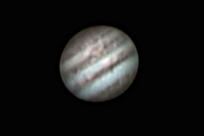 |
The same AVI as used above was aligned and stacked in K3CCDTools, wavelets and colour tweaks in Registax 2 then unsharp mask using The Gimp. | ||
| to top | home | ||
2 March 2004: Jupiter with Great Red Spot -- Alternative processing 2
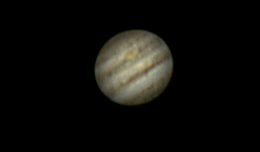 |
A third processing method for the save capture shown above, the frames were aligned and stacked in K3CCDTools as usual, then instead of Registax wavelets, multiple unsharp masks were applied directly in The Gimp. Finally the Red, Green and Blue channels were aligned using AstroAlign. I was pleasantly surprised at the result despite the absence of wavelet processing. | ||
| to top | home | ||
1 March 2004: Jupiter -- with "blue streak"
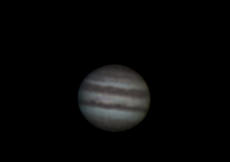 |
This image shows the recently-discovered "blue" disturbance (described here). This capture was aligned and stacked in K3CCDTools, wavelets and colour tweaks applied in Registax 2 then unsharp mask and colour curve adjusted using The Gimp. The Red, green, and blue channels were aligned using AstroAlign. Colour balancing was also adjusted in IrfanView to get the best image possible. | ||
| to top | home | ||
19 Feb 2004: Jupiter with the Galillean Satellites
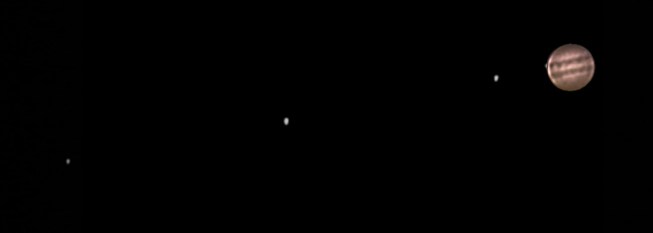
|
|||
|
This picture is a composite of short exposures (1/1000s) to bring out the planet's details, and longer ones (1/250s) to capture the satellites. Each was stacked with K3CCDTools then processed with Registax 2 and The Gimp. Click image for details.
Europa is just visible on the edge of the planet's disc. It was actually just beginning to pass in front of Jupiter, but the cut and paste has resulted in it appearing behind. |
|||
| to top | home | ||
| 8 Feb 2004: First Light for my new camera -- and My First Jupiter! 
|
Taken with the new Philips ToUCam Pro at prime focus (No Barlow) on my Meade EQ1-B 114mm reflector. AVI aligned and stacked with K3CCDTools then processed with Registax 2, The Gimp, and NeatImage. Click hereto see a single unprocessed frame. |
||
| to top | home | ||
 |
|||
| All text and images copyright and may not be used without permission |
|||